Mums are autumnal favorites that highlight the border and container arrangement. With the right cultural conditions, the ornamental perennial is an easy-care, long-lasting garden performer.
While chrysanthemums are mostly trouble-free, they are susceptible to common fungal diseases and viruses. Early detection helps plants recover from infections and prevents their spread. Here, we’ll explore common diseases among the quintessential fall bloomers, as well as how to treat and prevent them.
Setting Mums Up For Success
Providing the best growing conditions for chrysanthemums builds robust root systems and resilient plants. They grow best in full sun, and morning sun exposure as part of their daily dose is ideal. They prefer fertile, loamy, or sandy soils with good drainage. Good air circulation is essential for preventing fungal diseases.
The best time to plant mums is in the fall or spring when roots can establish before freezing or hot temperature extremes. For fall planting, ensure you get them in the ground six to eight weeks before heavy frosts helps roots develop before winter.
Planting nursery mums late in the fall presents a risk of surviving winter since most of their energy goes into flowering rather than establishing roots. Protect roots with an insulating layer of mulch. Use a light layer of mulch or soil on crowns or evergreen boughs for added protection against ice and frost heaving as soils freeze and thaw.
The perennials overwinter in containers, too; transplant them into larger pots and place them in a cool, sheltered location like a garage or basement until the warming temperatures of spring. Check the soil occasionally for moisture to keep roots from drying out completely.
Over time, the central plant becomes less vigorous. Dividing the main clump prevents overcrowding and promotes flowering. It creates new plants for years of recurrent color. In addition to expanding the collection, division also rejuvenates growth.
Powdery Mildew
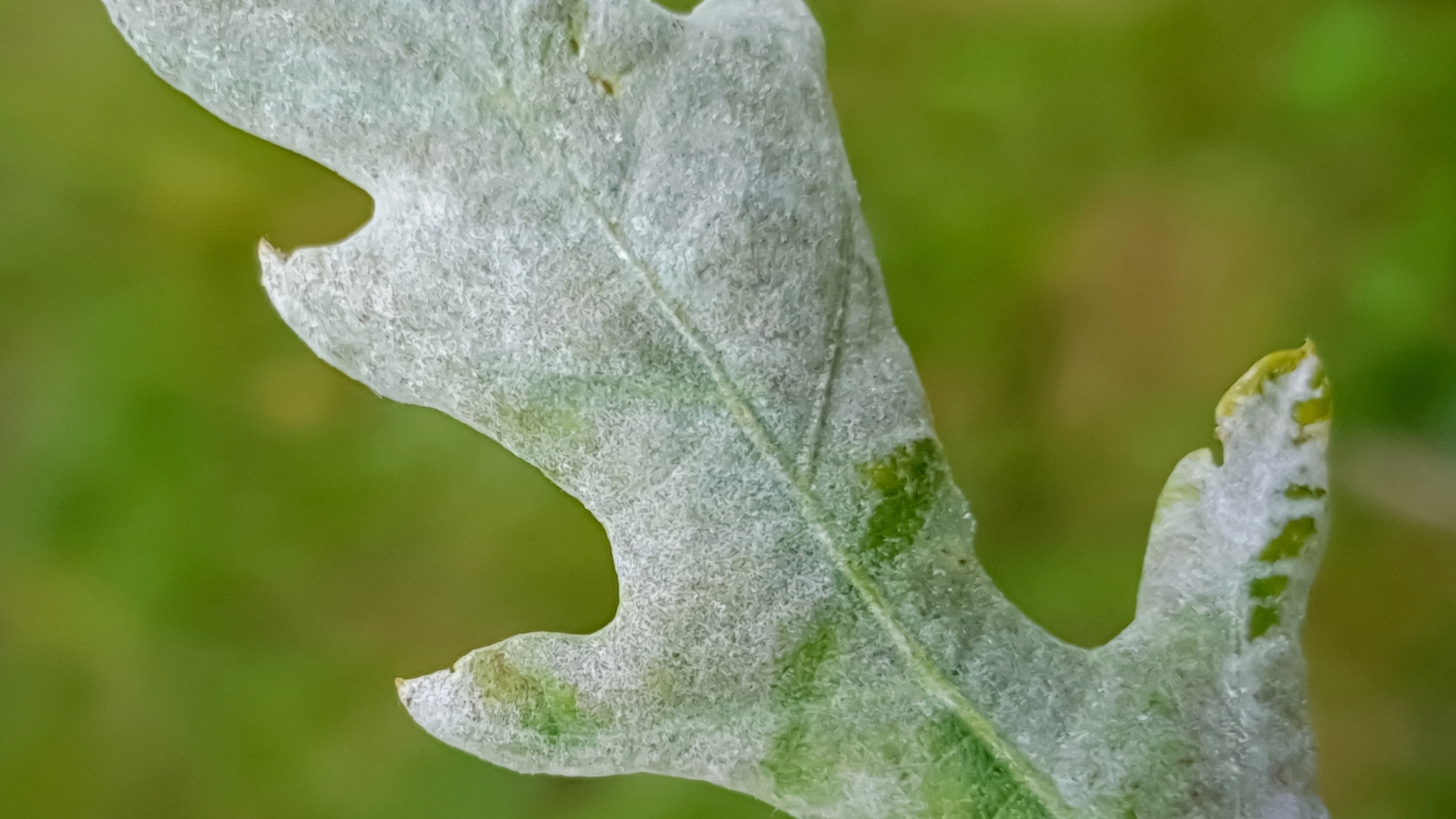
Powdery mildew is one of the most common fungal problems and affects numerous plants, from vegetables to ornamentals, including mums. The pathogen Erysiphe appears as a grayish-white dust on leaves, buds, and stems.
Spores spread on the wind, through contact with infected plants or tools, or by splashing up from the soil via raindrops and irrigation. The spores begin on the leaves and spread to the stems, depleting energy and nutrition.
Leaves turn yellow, distort, and drop during severe infections. The fungus spreads quickly, and if left untreated, plants wither and eventually die. Fortunately, powdery mildew is treatable with early detection and doesn’t usually kill mums.
Treatment
Handpick and remove the leaves when feasible. Throw them away in a garbage bag or burn pile separate from the compost pile.
For more extensive outbreaks, horticultural oils like neem or insecticidal soaps can treat powdery mildew early on. Organic elements in fungicides like bicarbonate may be suitable. Follow application directions, as these treatments may impact beneficial insects that visit plants for nectar and pollen. Application time of day is important in using products effectively.
Prevention
To avoid splashing water on the foliage, water at the base of the stems. Splashing transmits spores and fosters their ideal environment. Avoid overfertilizing, too – mums are heavy feeders and benefit from a balanced fertilizer in spring. Too much nitrogen leads to weak, leafy growth that’s susceptible to disease.
Leaf Spot
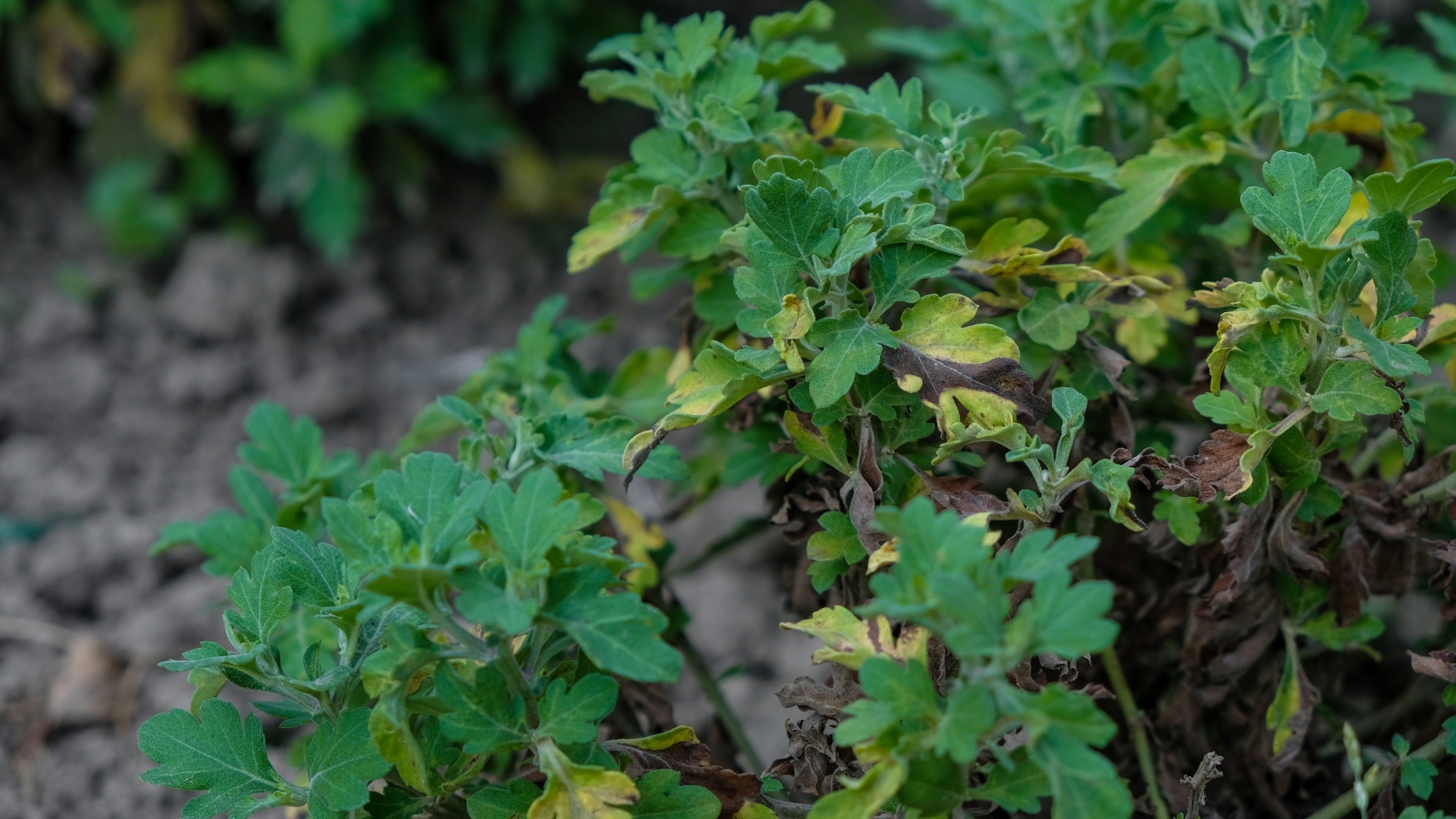
Leaf spot is a fungal infection that grows on leaf surfaces. Brown spots with lighter centers increase in size and number and spread across leaves and stems. The fungi cause leaves and stems to blacken.
The brown-black spots crop up when leaves stay wet from prolonged moisture from rain or overhead watering. Several pathogens, including Phoma, Botrytis, Cercospora, Cylindrosporium, Phyllosticta, and Septoria, may cause leaf spot.
Treatment
Early detection is the best control for leaf spot. Pluck diseased leaves and remove any dropped ones. Prune surrounding plants where appropriate to increase air circulation.
For chrysanthemums in containers, provide space between other pots. Scout regularly to remove any affected leaves as spots pop up.
Prevention
Ample air circulation is the best defense against leaf spot. Also, water at the ground level rather than spraying the leaves to reduce damp conditions. Mulch around chrysanthemums to reduce soil splash during watering (and for other benefits like insulation and moisture retention).
Rust
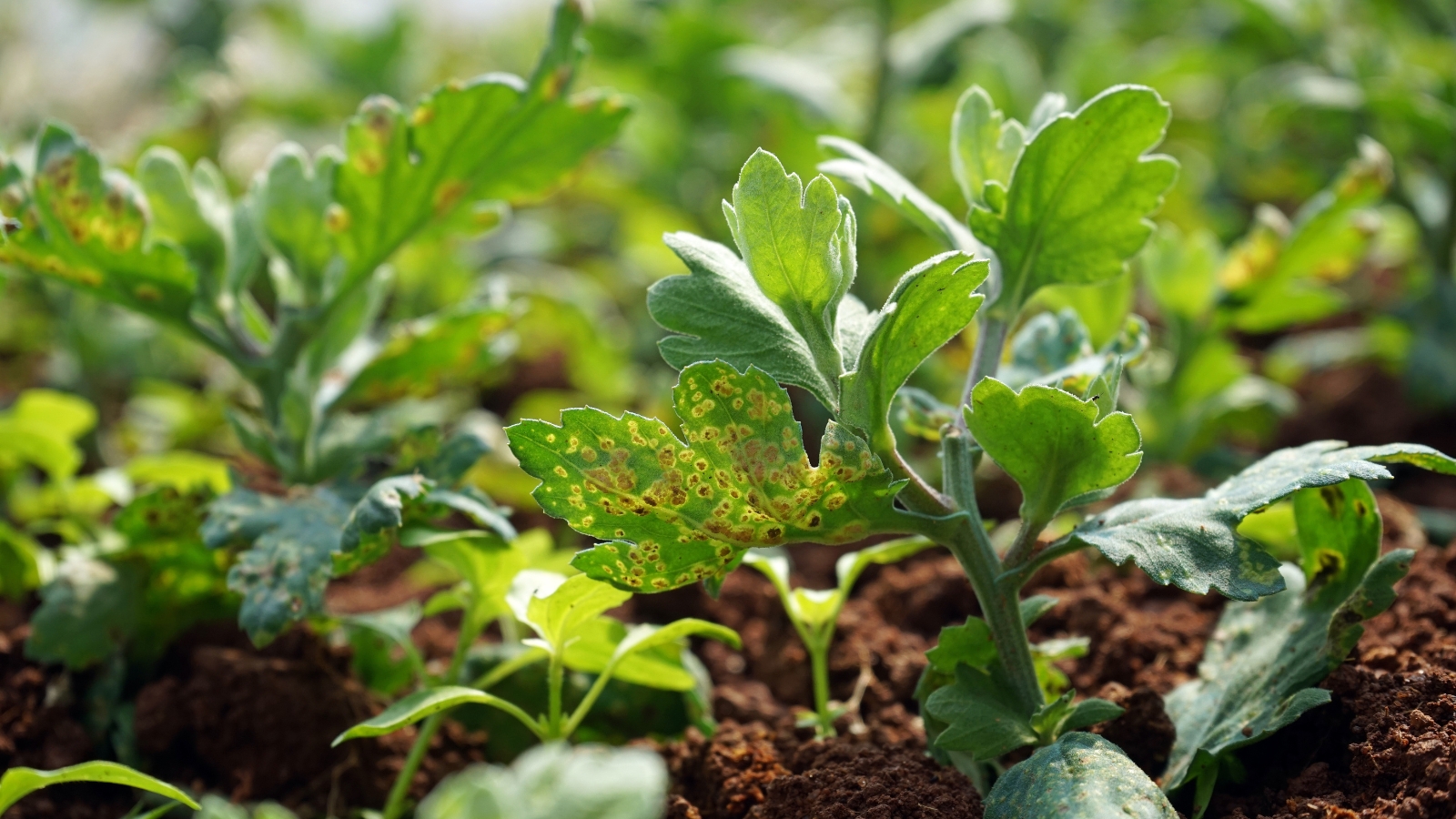
Rust is all too common in hot and humid growing areas. Leaves may have powdery spores on their undersides and will yellow, wilt, and drop early.
Rust spores erupt with yellow mold caused by the specialized pathogens Puccinia chrysanthemi and P. horiana, a white rust with light spores.
Some chrysanthemum varieties are rust-resistant. If you have a history of the problem, look for: ‘Achievement’, ‘Copper Bowl’, ‘Escapade’, ‘Helen Castle’, ‘Mandalay’, ‘Matador’, ‘Miss Atlanta’, ‘Orange Bowl’, and ‘Powder Puff.’
Treatment
Cut off any rust-infected leaves and plant parts. Rust spreads easily, so discard the debris away from garden areas.
Horticultural oils like neem and fungicides treat fungal diseases in their early stages. Removal is the best option for any severely impacted plants.
Prevention
As with leaf spot (and many other diseases), the best way to prevent rust is to increase air movement, especially in humid conditions. Watering at the soil level delivers moisture to the roots without spraying foliage.
Root Rot
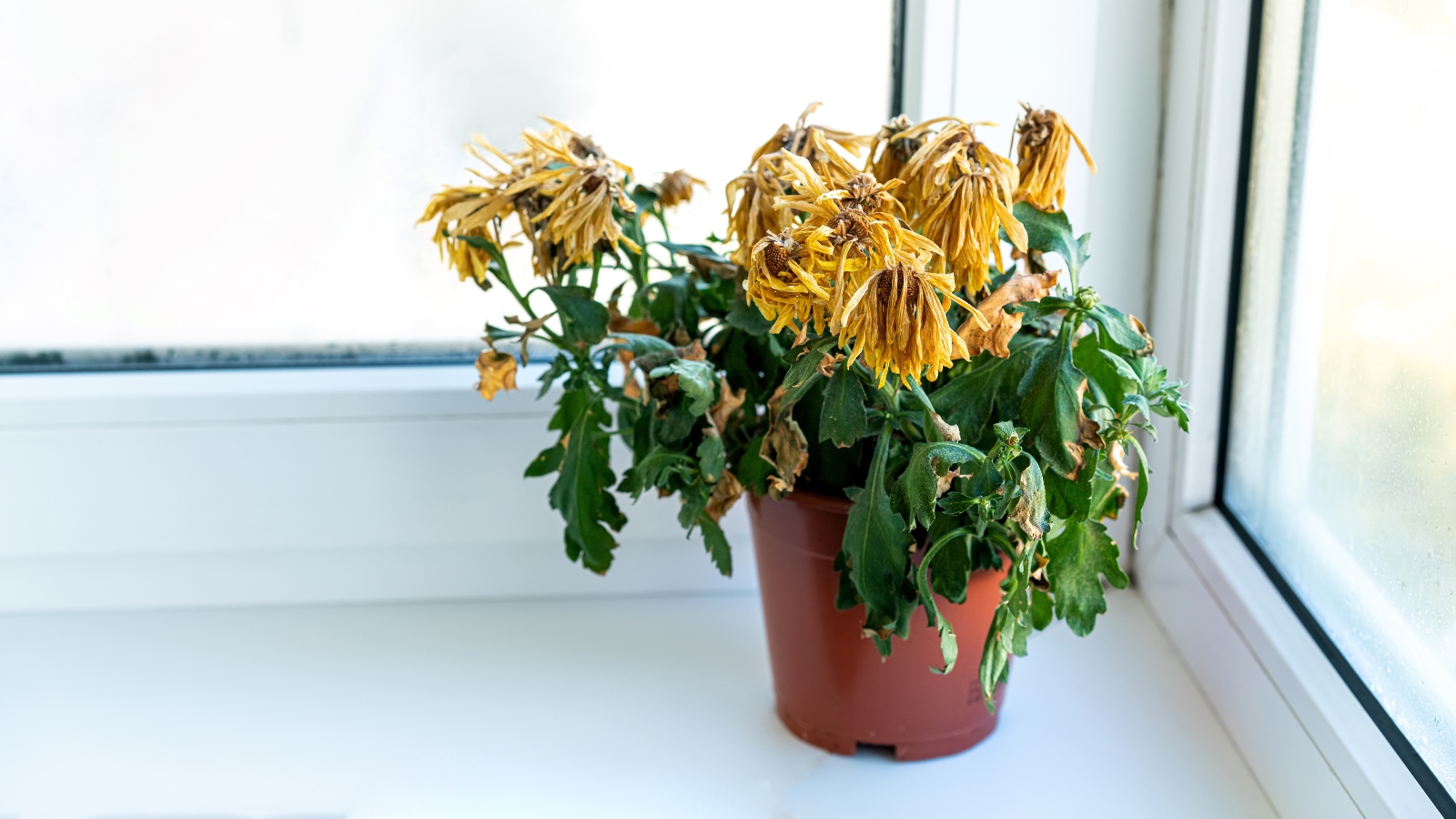
Fungal root rot causes plants to decline due to a lack of moisture and nutrient absorption. The pathogens Phymatotrichopsis or Phytophthora impact feeder roots, preventing them from uptaking water and nutrients. Leaves appear drought-stressed, turn yellow, and wilt.
Look for rot slightly below the soil level. If a mum is experiencing rot, the stems will be yellow, and the roots will be brown and mushy rather than a healthy white.
Treatment
If caught early and with only minor damage, mums can recover. Reduce irrigation frequencies to allow oversaturated soils time to drain. Keep soil evenly moist but not soggy.
To improve soil drainage, repot container specimens, cultivate the soil around existing plants, or tranplsnt them to higher, mounded ground.
Prevention
Proper cultural management, especially not overwatering, is the best control. We can’t emphasize good drainage enough when it comes to chrysanthemums.
Water deeply and increase the length of time between sessions if needed. Deep watering allows better absorption over frequent, shallow watering. Allow plenty of airflow between plants and surrounding containers or structures.
Wilt
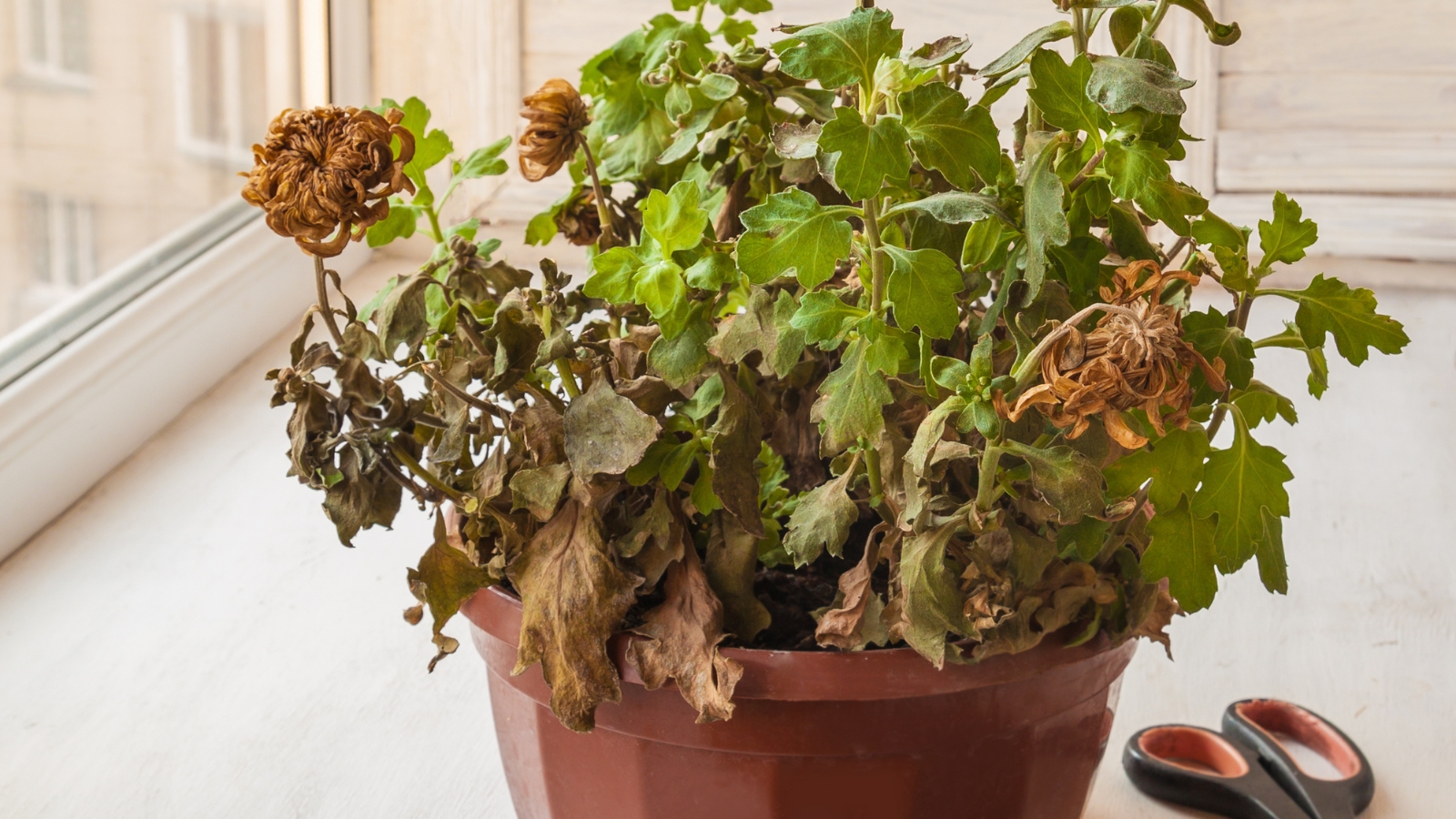
Fusarium and Verticillium wilt are fungal diseases that cause wilting, blackened leaves and stems, and decline. They spread from spores in the soil and arrive with infected seeds or transplants. Wind, water, and garden tools also spread the spores.
The fungus impacts the roots and affects nutrient and water uptake. With fungal wilts, you may see one half of the mum wilting more than the other, followed by leaves dropping. Cut stems may show brown tissues.
Treatment
Unfortunately, there’s no treatment for these wilts. To prevent them from spreading, remove and dispose of the impacted plants.
Prevention
To prevent wilt, start with plant siting. Grow the perennials in a spot with at least six hours of sunlight, in rich soils with good drainage, and with plenty of airflow.
Minimize root stress by situating new additions in loose soils with room to grow. Add a layer of mulch, keeping it away from stems to prevent rot.
If wilt becomes an issue, check the soil pH. A pH of 6.5-7.0 is ideal for chrysanthemums.
Botrytis
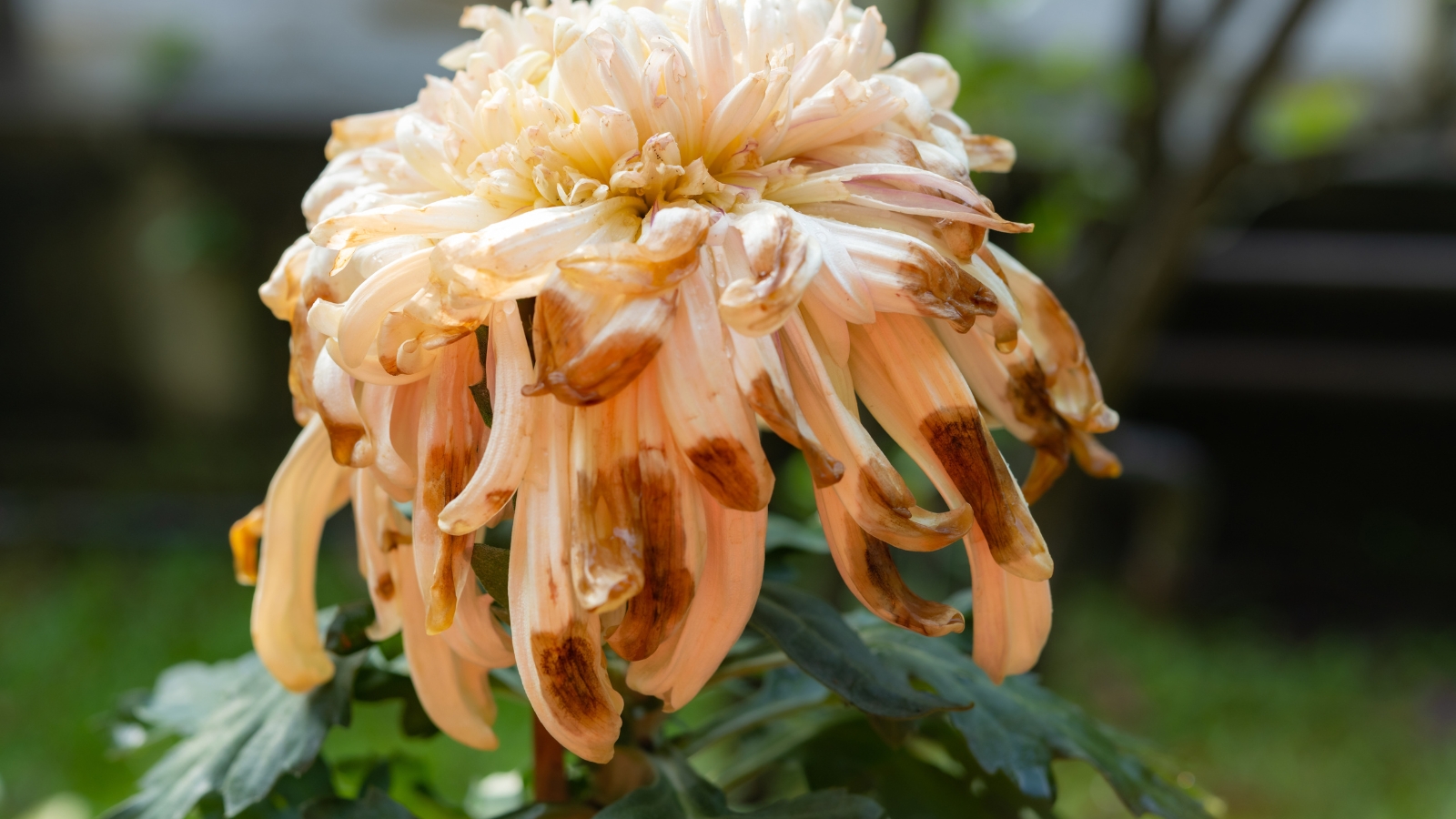
Botrytis cinerea is a blight (also called gray mold) indicated by light grayish-brown watery spots on lower petals, spreading to others. Leaves and flowers discolor, and brown spots and “fluffy mold” appear.
Botrytis thrives in the cool, humid conditions of spring and fall. It affects a wide range of plants, from ornamentals to food crops.
Treatment
Botrytis is an adaptable fungus that adjusts to fungicidal treatments. Employ foliar organics and soil microbes to keep the spores from developing immunity.
Neem oil is effective early on, as is potassium bicarbonate. Use a powdered formula mixed with water as a regular spray treatment, Mycorrhiza and beneficial bacteria added to the soil are suitable countermeasures. Look for Trichoderma and Cladosporium to ward off botrytis.
Prevention
To avoid botrytis is avoiding lingering moisture. Take care not to overwater or overfertilize, which weakens the plant and increases susceptibility.
Like crown and root rot, botrytis thrives in high-humidity conditions with limited air circulation. Space plants for ample airflow and follow proper watering that avoids wetting the leaves unnecessarily. Remove fallen debris that can harbor spores.
Bacterial Blight
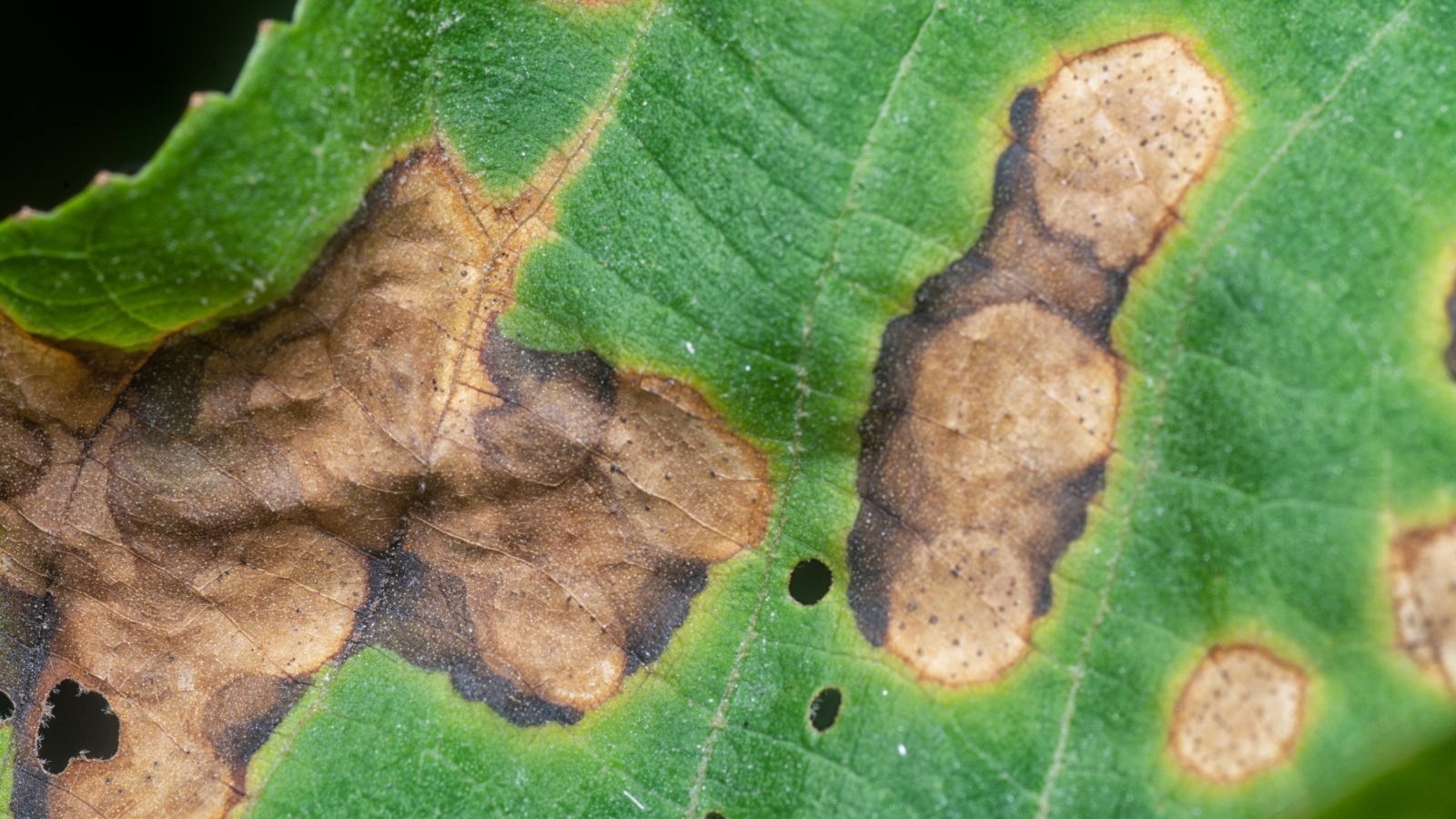
Erwinia chrysanthemi is most evident early in the growing season and at the cuttings stage. Upper stems show rot and drooping. Cuttings turn blown and collapse. Those that mature may wilt during the day and rebound in the evening.
Treatment
Discard infected cuttings, saving only those that appear unaffected. For established plants, prune below visible symptoms to healthy tissue.
Prevention
Use clean, soilless potting media and sanitized containers to propagate mums. Avoid planting in wet conditions and prolonged saturation.
Ray Blight
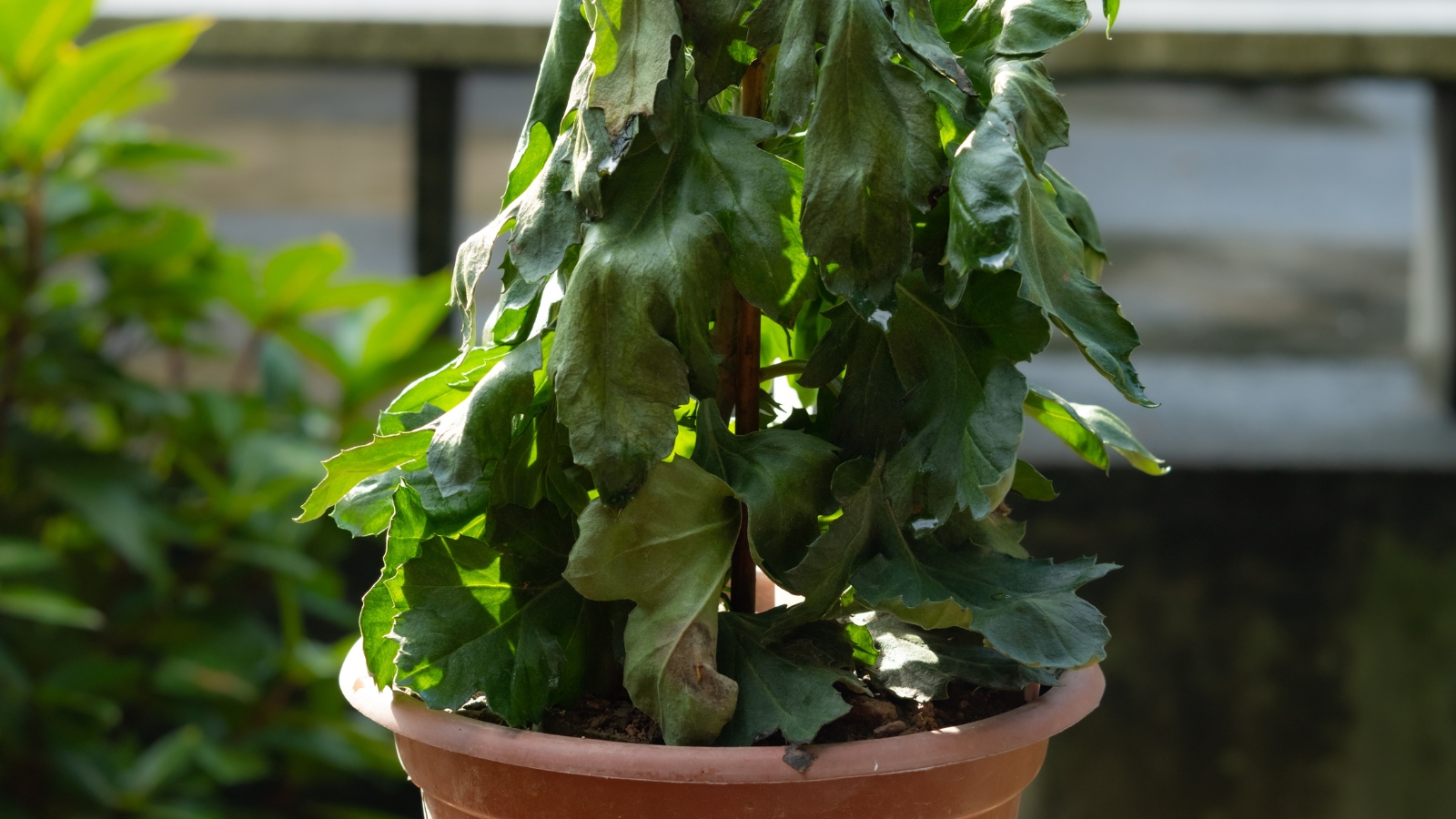
Ascochyta ray blight is a fungus whose symptoms develop on all parts, including the roots. It appears with brownish-black leaf spots and stem lesions and results in malformed blooms with one side of the bud stunted.
Petals have brown discoloration, and the blight progresses deeper into the petiole and base of bloom; Shaken petals fall in a shower, and the whole flower may turn black and wilt.
Treatment
In mild cases, remove infected leaves and parts and monitor recovery. Dispose of severely impacted selections.
Prevention
The first step is to source healthy selections from a reliable grower. Next, reduce overhead watering and increase airflow – the fungus grows in humid, damp conditions.
It also persists in soils over the winter; remove fallen debris and practice crop rotation by not replanting mums or Asteraceae family members the next season.
Viruses
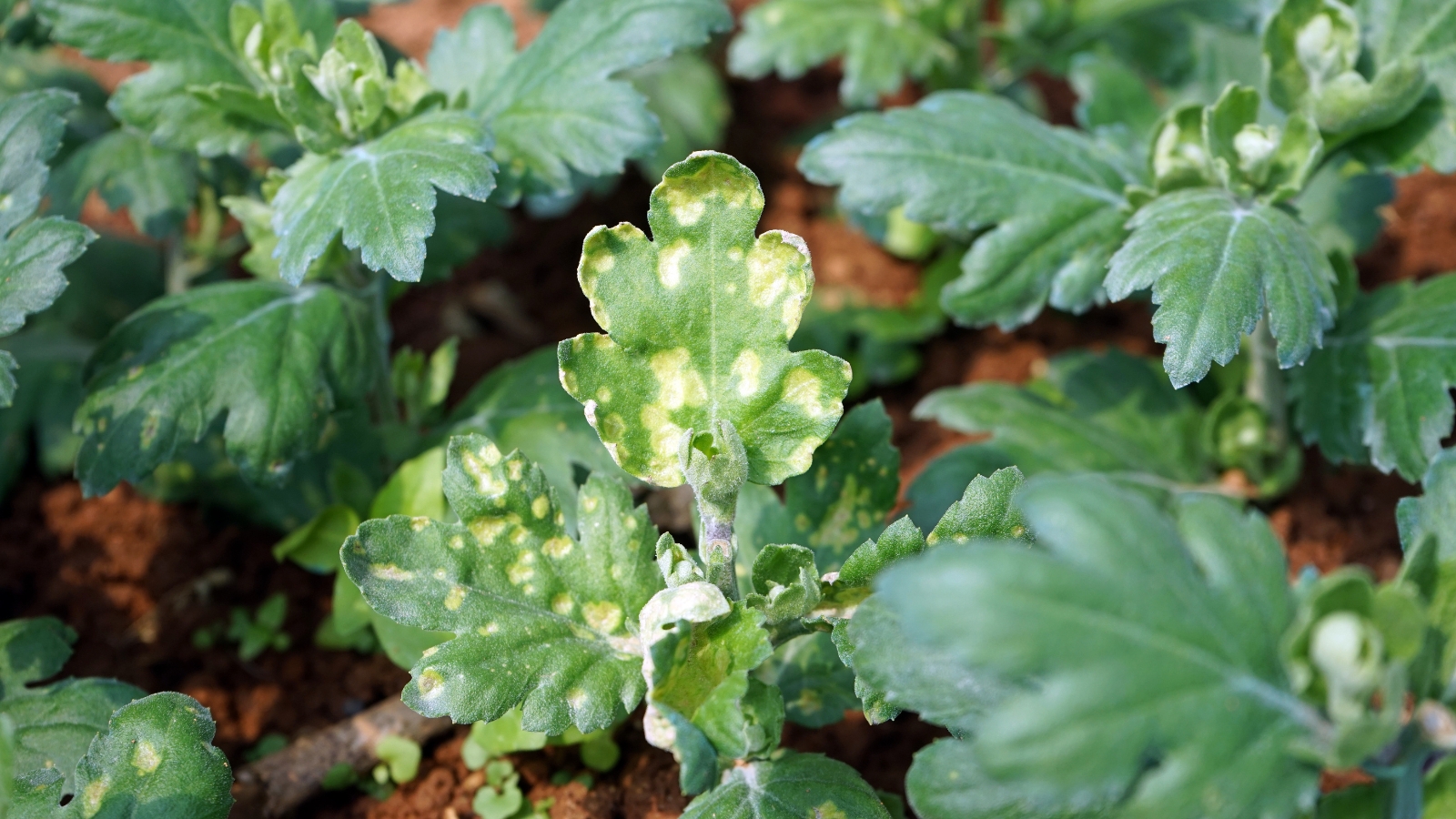
Several viruses affect mums, like tobacco mosaic virus, stunting, and aster yellows. Sap-sucking insects like aphids, leafhoppers, and spider mites are vectors for spreading viruses.
| Virus | Indicator |
| Tobacco Mosaic Virus | Mottled mosaic pattern on leaves, followed by curling and distorting |
| Chrysanthemum Stunt Viroid (Stunt) | Dwarfed growth, smaller flowers, premature flowering; leaves are light green or turn reddish |
| Aster Yellows | Caused by a phytoplasma spread by leafhoppers; deformed, green flowers and small, weak shoots; overall yellowing |
Treatment
Unfortunately, viruses do not have a treatment. The best action is to spot them early and remove infected plants.
Prevention
Treat severe insect infestations to avoid viral pathogens. Remove any fallen leaves and debris to prevent the spread, and disinfect tools. Provide the best cultural practices of consistent watering and nutrient-tich soils with good drainage.



